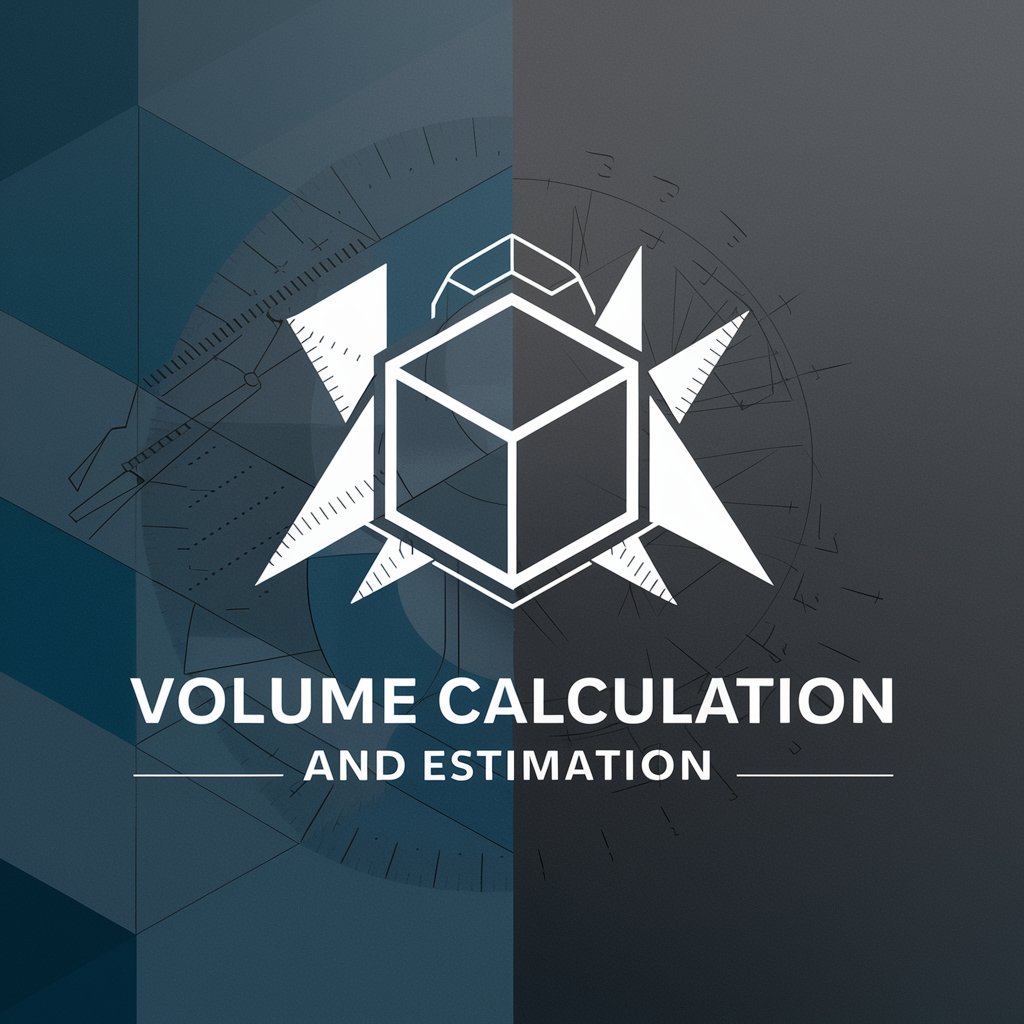Volume Calculation and Estimation - Accurate Volume Estimation

Hello! Let's explore volume calculations together.
Powering precision with AI-based volume estimation
Calculate the volume of a cylindrical tank with...
Estimate the volume of an irregularly shaped object like...
How can I determine the volume of a rectangular prism when...
What is the volume of a sphere given its radius is...
Get Embed Code
Introduction to Volume Calculation and Estimation
Volume Calculation and Estimation is designed to provide precise and approximate measurements of three-dimensional spaces or objects. This tool is crucial in various fields, such as construction, where accurate volume calculations can determine the amount of materials needed, or in shipping, to estimate space requirements and costs. The core functionality revolves around applying mathematical formulas and techniques to compute the volume of different shapes and objects, ranging from simple geometrical figures like cubes and spheres to more complex structures through integration and approximation methods. For example, calculating the volume of a swimming pool to determine the amount of water needed to fill it, or estimating the soil volume required to fill a garden bed, showcases the practical applications of these calculations. Powered by ChatGPT-4o。

Main Functions of Volume Calculation and Estimation
Geometric Volume Calculation
Example
Calculating the volume of a cylinder for a manufacturing process.
Scenario
A company needs to produce a cylindrical tank and must know its volume to estimate material costs and capacity. The calculation uses the formula V = πr^2h, where V is volume, r is radius, and h is height.
Approximation Techniques
Example
Estimating the volume of an irregularly shaped pond.
Scenario
Environmental scientists need to determine the volume of a natural pond for ecological studies and resource management. Approximation methods, such as dividing the pond into sections and estimating each section's volume, are used.
Construction Material Estimation
Example
Determining the amount of concrete needed for a slab.
Scenario
In construction, accurately estimating the volume of concrete required for a foundation slab is critical. This involves calculating the slab's volume by multiplying its length, width, and thickness.
Space Optimization
Example
Maximizing storage space in a warehouse.
Scenario
Warehouse managers use volume estimation to optimize storage strategies, determining how to best utilize available space by calculating the volume of storage units and comparing it with the volume of goods to be stored.
Ideal Users of Volume Calculation and Estimation Services
Construction Professionals
Architects, engineers, and contractors benefit from precise volume calculations for planning, budgeting, and executing construction projects, ensuring the efficient use of materials and space.
Environmental Scientists
These professionals require volume estimations for environmental impact assessments, water resource management, and ecological research, especially when dealing with natural formations and bodies of water.
Logistics and Warehouse Managers
Efficient space management and cost estimation for shipping and storage are crucial. Volume calculation aids in optimizing the use of containers, trucks, and storage facilities.
Educators and Students
In educational settings, learning about volume calculation and estimation is fundamental in mathematics and science courses, providing practical applications of theoretical knowledge.

How to Use Volume Calculation and Estimation
Start with a Free Trial
Head to yeschat.ai for a no-login, complimentary trial, eliminating the need for ChatGPT Plus.
Understand the Basics
Familiarize yourself with volume calculation principles and the types of volumes you can estimate with this tool.
Prepare Your Data
Gather all necessary dimensions and details of the object or space for which you are calculating volume. Accurate measurements are key.
Input Your Data
Enter your measurements into the tool. Be specific about units (e.g., meters, liters) to ensure accuracy.
Analyze Results
Review the volume estimation provided. Use the tips and guidelines offered by the tool for interpreting and applying your results effectively.
Try other advanced and practical GPTs
Analista de Comportamento Visual
Unlock the secrets of body language with AI.

DC Test
Powering Insights with AI

Tainted Metal meaning?
Illuminate Ideas with AI Insight

On The Rise meaning?
Empowering insights with AI

Fallout meaning?
Unravel Complexity with AI Insight

Replace You meaning?
Enhance Your Writing with AI

Gerador de Imagens (IA que cria Imagens)
Bringing Your Ideas to Visual Reality

Maître Chinois
Master Chinese with AI-powered Cultural Insights

The Chairman
Empowering Decision-Making with AI Insight

Vocabulary Master (God of Numbers)
Empowering Language Mastery with AI

QubitGPT
Expanding AI with Quantum Depth

Photo Mentor
Elevate Your Photography with AI

FAQs on Volume Calculation and Estimation
What is volume calculation and estimation?
Volume calculation and estimation is a process used to determine the amount of space occupied by a 3D object or contained within a region, applying mathematical formulas based on shape and dimensions.
Can this tool estimate volume for irregular shapes?
Yes, the tool can estimate volume for irregular shapes by breaking them down into simpler, measurable units or using advanced algorithms to approximate their volume.
How accurate are the volume estimations?
The accuracy of volume estimations depends on the precision of the input data and the complexity of the object's shape. For standard shapes, the estimations are highly accurate; for irregular ones, they are approximations.
Are there any prerequisites for using the tool?
The primary prerequisite is having detailed dimensions of the object or space. Knowledge of basic geometry can also enhance your understanding and use of the tool.
Can this tool be used in educational settings?
Absolutely. The tool is an excellent resource for teaching and learning about volume calculation, offering practical applications for geometry and mathematics education.
